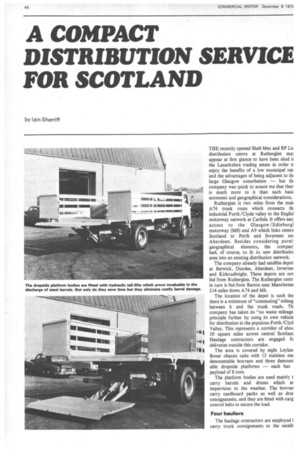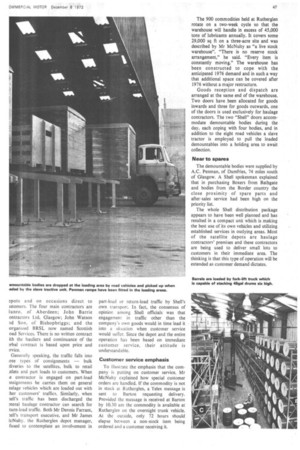A COMPACT DISTRIBUTION SERVICE FOR SCOTLAND
Page 48

Page 49

If you've noticed an error in this article please click here to report it so we can fix it.
THE recently opened Shell-Mex and BP Ltc distribution centre at Rutherglen ma] appear at first glance to have been sited ii the Lanarkshire trading estate in order ti enjoy the benefits of a low municipal rat and the advantages of being adjacent to tit, large Glasgow conurbation — but th, company was quick to assure me that then is much more to it than such basil economic and geographical considerations.
Rutherglen is two miles from the maii A74 trunk route which connects th industrial Forth /Clyde valley to the Englisl motorway network at Carlisle. It offers eas: access to the Glasgow /Edinburg' motorway (M8) and A9 which links centre Scotland to Perth and Inverness an Aberdeen. Besides considering purel: geographical elements, the compan had, of course, to fit its new distributia area into an existing distribution network.
The company already had satellite depot at Berwick, Dundee, Aberdeen, Invernes and Kirkcudbright. These depots are no fed from Rutherglen. The Rutherglen centr in turn is fed from Barton near Manchestei 214 miles down A74 and M6.
The location of the depot is such tha there is a minimum of "commuting" mileag between it and the trunk roads. Th company has taken its "no waste mileage principle further by using its own vehicle for distribution in the populous Forth /Clyd Valley. This represents a corridor of abou 50 square miles across central Scotian( Haulage contractors are engaged fa deliveries outside this corridor.
The area is covered by eight Leylan Boxer chassis cabs with 12 stainless stel demountable boxvans and three demouni able dropside platforms — each has payload of 8 tons.
The platform bodies are used mainly t carry barrels and drums which ar impervious to the weather. The boxvar carry cardboard packs as well as drut consignments, and they are fitted with carg control belts to secure the load.
Four hauliers The haulage contractors are employed I carry trunk consignments to the satellii
2pots and on occasions direct to Istomers. The four main contractors are Eunro, of Aberdeen; John Barrie ontractors Ltd, Glasgow; John Watson 'id Son, of Bishopbriggs; and the :organized BRSL now named Scottish oad Services. There is no written contract ith the hauliers and continuance of the ;rbal contract is based upon price and
Generally speaking, the traffic falls into ,ree types of consignments — bulk ;liveries to the satellites, bulk to retail Ales and part loads to customers. When ,e contractor is engaged on part-load )nsignments he carries them on general 'Wage vehicles which are loaded out with her customers' traffics, Similarly, when traffic has been discharged the ;neral haulage contractor can search for turn-load traffic. Both Mr Dennis Farrant, transport executive, and Mr James ieNulty, the Rutherglen depot manager, fused to contemplate an involvement in
part-load or return-load traffic by Shell's own transport. In fact, the consensus of opinion among Shell officials was that engagement in traffic other than the company's own goods would in time lead it into a situation when customer service would suffer. Since the depot and the entire operation has been based on immediate customer service, their attitude is understandable.
Customer service emphasis
To illustrate the emphasis that the company is putting on customer service, Mr McNulty explained how special customer orders are handled. If the commodity is not in stock at Rutherglen, a Telex message is sent to Barton requesting delivery. Provided the message is received at Barton by 10.30 am the commodity is available at Rutherglen on the overnight trunk vehicle. At the outside, only 72 hours should elapse between a non-stock item being ordered and a customer receiving it.
The 900 commodities held at Rutherglen rotate on a two-week cycle so that the warehouse will handle in excess of 45,000 tons of lubricants annually. It covers some 29,000 sq ft on a three-acre site and was described by Mr McNulty as "a live stock warehouse". "There is no reserve stock arrangement," he said. "Every item is constantly moving." The warehouse has been constructed to cope with the anticipated 1976 demand and in such a way that additional space can be covered after 1976 without a major restructure.
Goods reception and dispatch are arranged at the same end of the warehouse. Two doors have .been allocated for goods inwards and three for goods outwards, one of the doors is used exclusively for haulage contractors. The two "Shell" doors accommodate demountable bodies during the day, each coping with four bodies, and in addition to the eight road vehicles a slave tractor is employed to pull the loaded demountables into a holding area to await collection.
Near to spares The demountable bodies were supplied by A.C. Penman, of Dumfries, 74 miles south of Glasgow. A Shell spokesman explained that in purchasing Boxers from Bathgate and bodies from the Border country the close proximity of spare parts and after-sales service had been high on the priority list.
The whole Shell distribution package appears to have been well planned and has resulted in a compact unit which is making the best use of its own vehicles and utilizing established services in outlying areas. Most of the satellite depots are haulage contractors' premises and these contractors are being used to deliver small lots to customers in their immediate area. The thinking is that this type of operation will be extended as customer demand dictates.








































































































